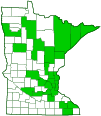Sharp-scaly Pholiota
(Pholiota squarrosoides)
Conservation • Description • Habitat • Ecology • Distribution • Taxonomy
Conservation Status |
|||
| IUCN Red List | not listed |
||
| NatureServe | NNR - Unranked |
||
| Minnesota | not listed |
||
Description |
Sharp-scaly Pholiota is a medium-sized gill mushroom. It is fairly widespread and not uncommon in deciduous woodlands in North America. It is found from September through October usually in a bouquet-like cluster, rarely singly. It can obtain its nutrients from living trees (parasitic) or dead wood (saprobic). It causes heartrot of living trees. The cap is 1¼″ to 4″ in diameter. It is convex at first, becoming broadly convex, broadly bell-shaped, or almost flat with a knob in the middle. It is whitish near the margin, pale orangish-brown or yellowish-brown (tawny) or light brown near the center. It is covered with conspicuous, erect or backward-curved, pointed, sharp, tawny scales. The surface below the scales is slimy when wet, sticky when moist, and smooth when dry. The margin is curved under at first and often has shreds of tissue, remnants of the developing gill’s protective covering (partial veil). The gills are closely spaced (crowded) and are broadly attached. They sometimes run down the stalk slightly. They are whitish at first, becoming dull rusty brown as the spores mature. They do not turn greenish before turning rusty brown. The stalk is solid, dry, 1½″ to 4″ long, and 3 ⁄16″ to ⅝″ thick. It is whitish, becoming reddish brown near the base. Near the top of the stalk there is a collar or ring of often torn tissue, the persistent remnants of the partial veil. Sometimes the veil tissue deteriorates completely, leaving just a ring zone of slightly different color. Above the ring or ring zone it is smooth. Below it is covered with conspicuous, tawny, erect or backward-curved scales. The flesh is whitish. It never has a garlic odor. It is edible but not recommended because of the similarity in appearance to Shaggy Pholiota, which has been reported to cause severe gastric upset. The spore print is dull rusty brown or cinnamon brown. |
Similar Species |
Shaggy Pholiota (Pholiota squarrosa) cap is pale tan, buff, or pale yellowish-brown, not whitish. The surface is always dry, never slimy or sticky. The gills are whitish to yellowish and pass through a greenish phase before turning reddish-brown. The flesh sometimes develops a garlicky odor. Note: The characteristics above overlap and are affected by weather conditions. Some authors believe the only way to distinguish between mature specimens of these two species is to examine the spores microscopically. |
Habitat and Hosts |
Hardwood forests. Living and dead hardwoods. |
Ecology |
Season |
September through October |
Distribution |
||
|
Sources Biodiversity occurrence data published by: Minnesota Biodiversity Atlas (accessed through the Minnesota Biodiversity Atlas Portal, bellatlas.umn.edu, 9/16/2025). |
|
| 9/16/2025 | ||
Occurrence |
||
Fairly widespread and not uncommon. |
||
Taxonomy |
|
Kingdom |
Fungi (Fungi) |
Subkingdom |
Dikarya |
Phylum |
Basidiomycota (Basidiomycete Fungi) |
Subphylum |
Agaricomycotina (Higher Basidiomycetes) |
Class |
Agaricomycetes (Mushrooms, Bracket Fungi, Puffballs, and Allies) |
Subclass |
Agaricomycetidae |
Order |
|
Suborder |
Agaricineae |
Family |
Strophariaceae |
Genus |
Pholiota (scalycaps) |
Subgenus |
Pholiota |
Section |
Adiposae |
Subordinate Taxa |
|
|
|
Synonyms |
|
Agaricus squarrosoides Dryophila ochropallida Hypodendrum squarrosoides Pholiota ochropallida |
|
Common Names |
|
Scaly Pholiota Sharp-scaly Pholiota |
|
Glossary
Parasitic
Obtaining nutrients from another living organism.
Partial veil
A protective covering over the gills or pores of a developing mushroom. At maturity it disappears, collapses into a ring around the stalk, or wears away into a cobwebby covering and ring zone.
Saprobic
A term often used for saprotrophic fungi. Referring to fungi that obtain their nutrients from decayed organic matter.
Tawny
Orangish-brown or yellowish-brown: the color of a lion.
Visitor Photos
Share your photo of this fungus.
This button not working for you?
Simply email us at info@MinnesotaSeasons.com.
Attach one or more photos and, if you like, a caption.
Robbi H |
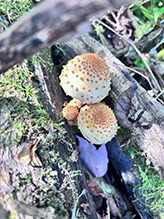 |
Kelly Roth |
||
found growing on maple log |
||
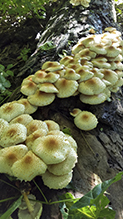 |
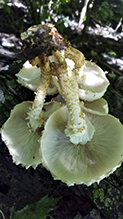 |
|
Margot Avey |
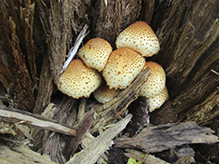 |
MinnesotaSeasons.com Photos
|

Slideshows

Visitor Videos
Share your video of this fungus.
This button not working for you?
Simply email us at info@MinnesotaSeasons.com.
Attach a video, a YouTube link, or a cloud storage link.
Other Videos

Visitor Sightings
Report a sighting of this fungus.
This button not working for you?
Simply email us at info@MinnesotaSeasons.com.
Be sure to include a location.
MinnesotaSeasons.com Sightings |
|

